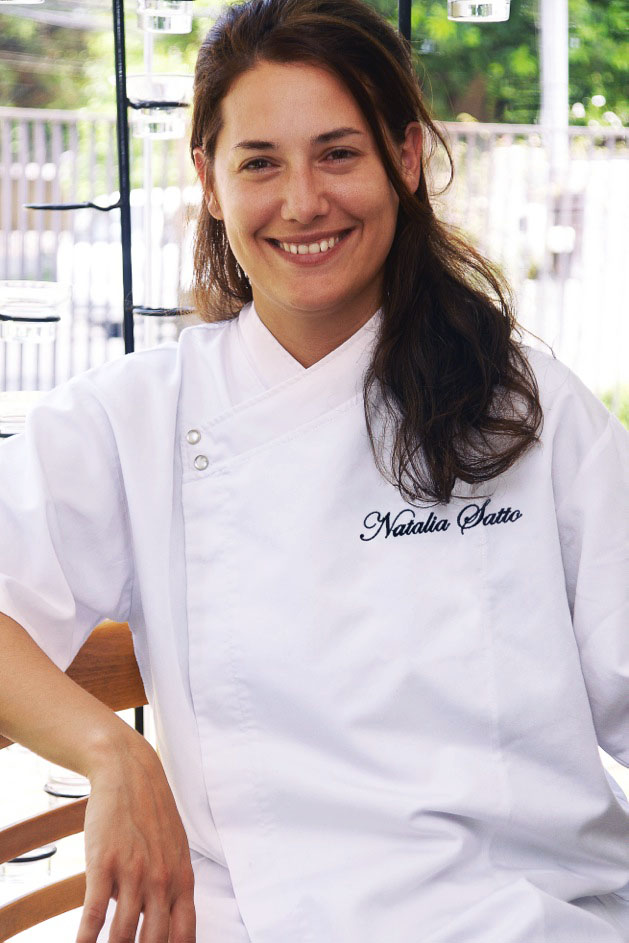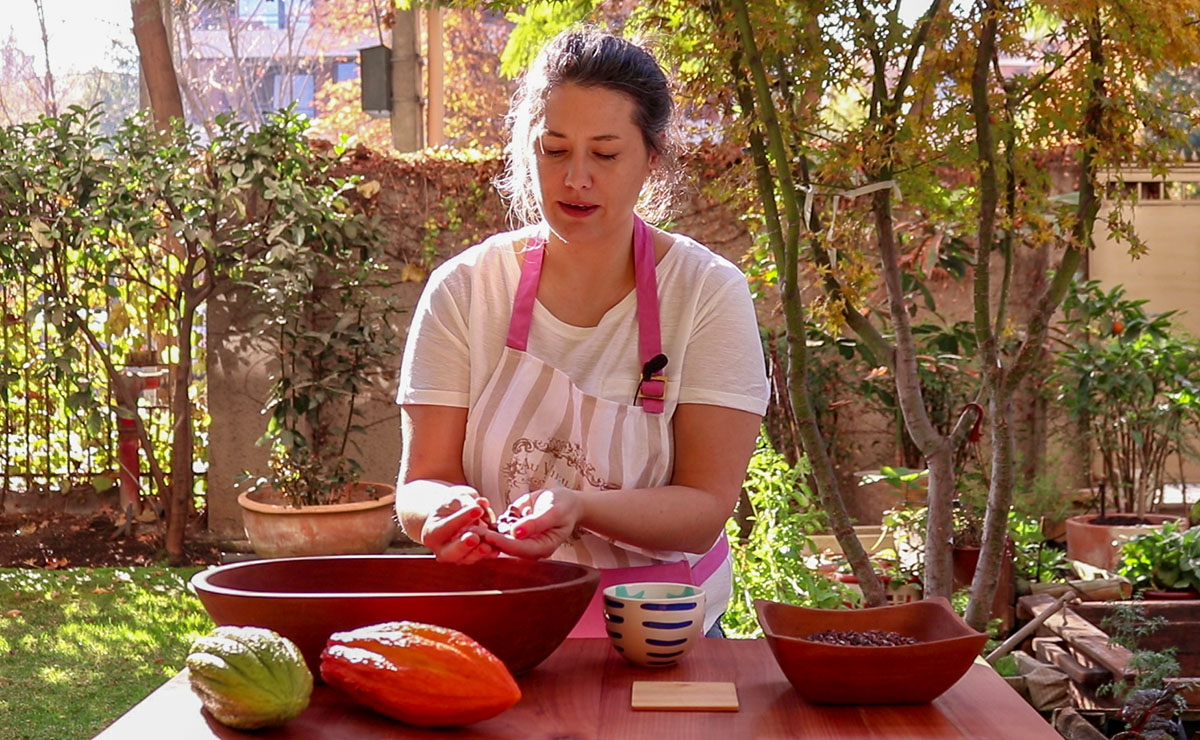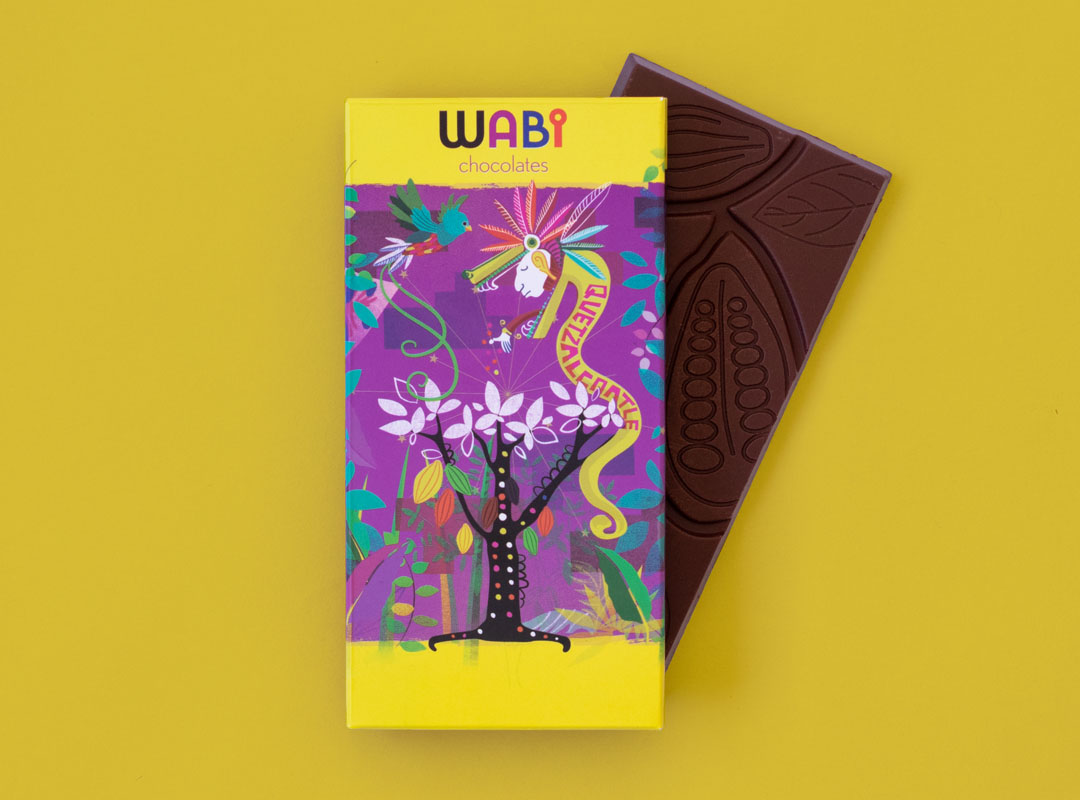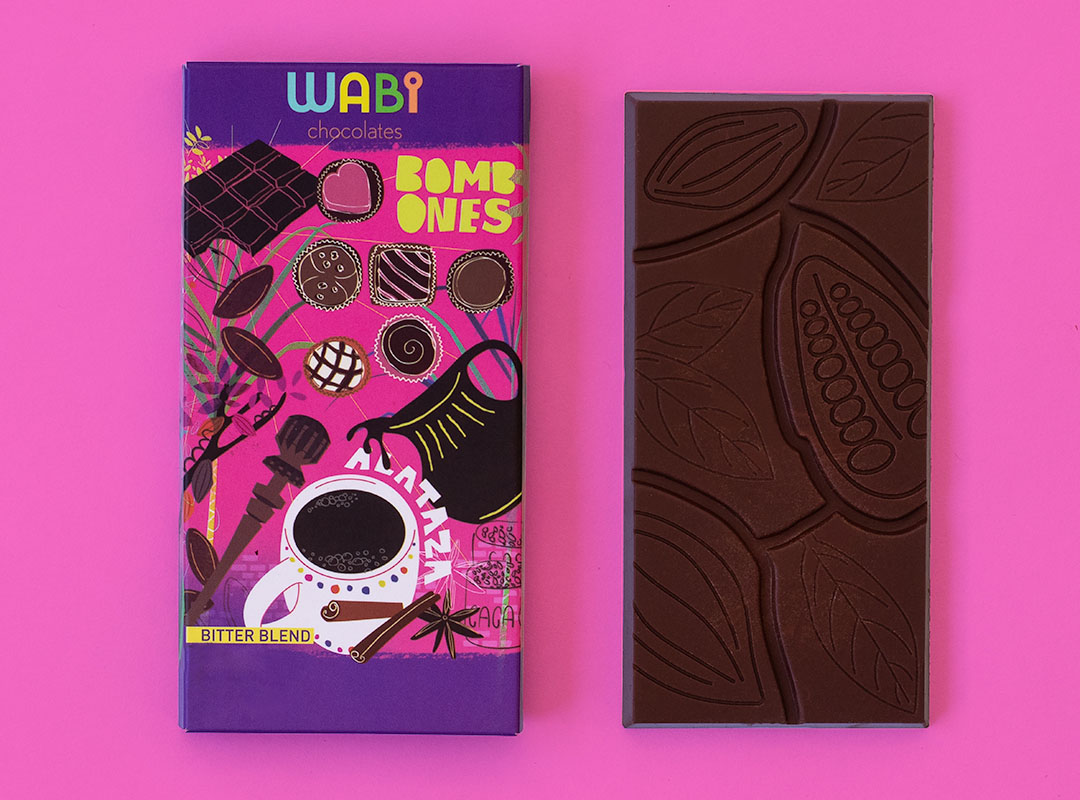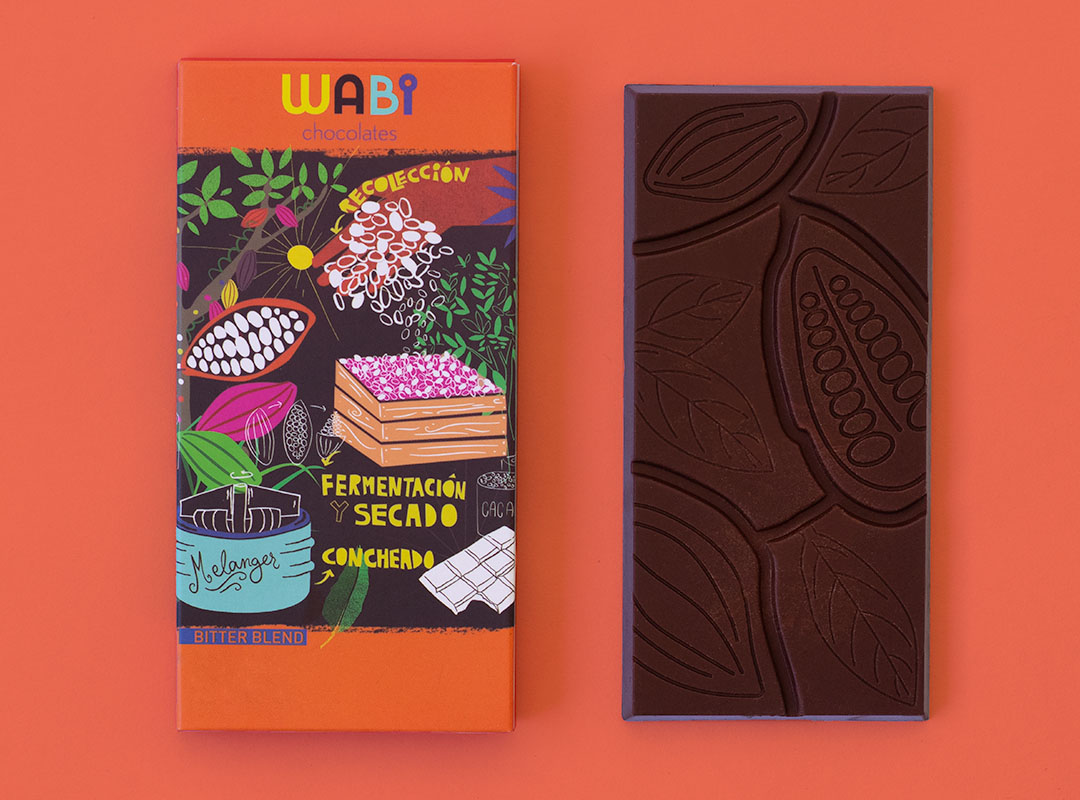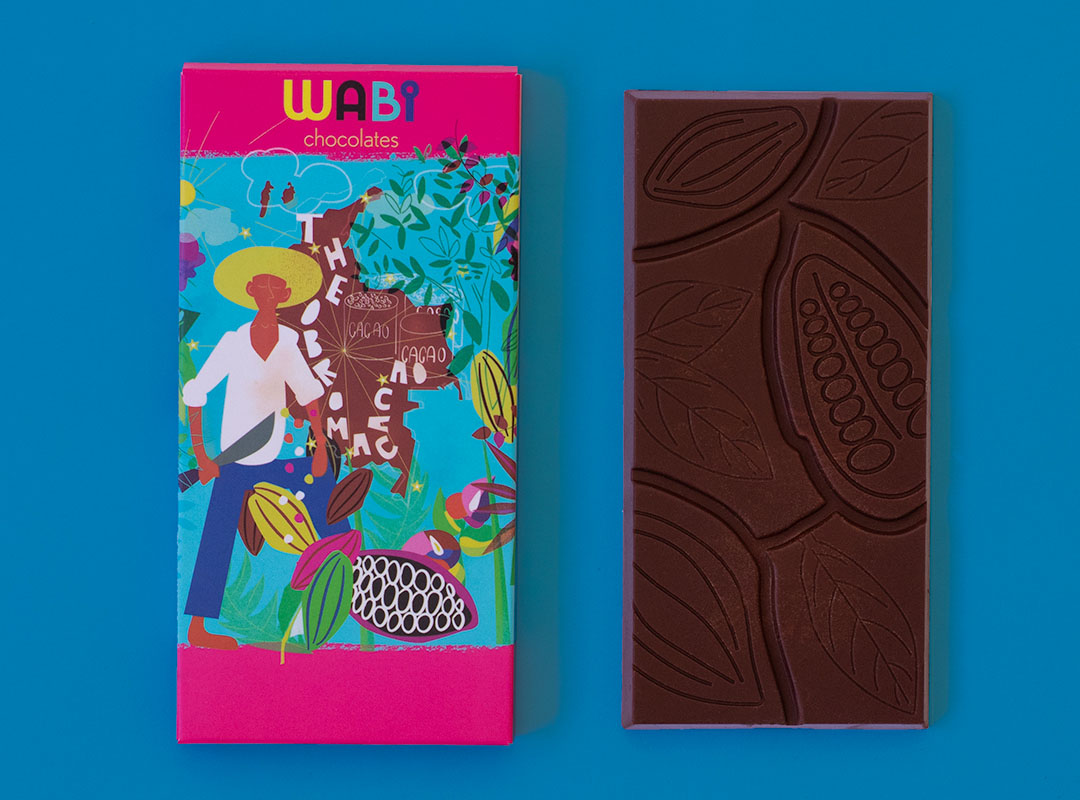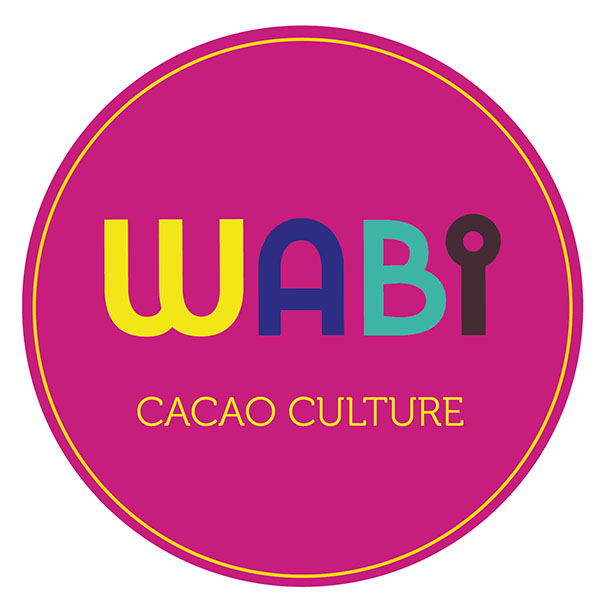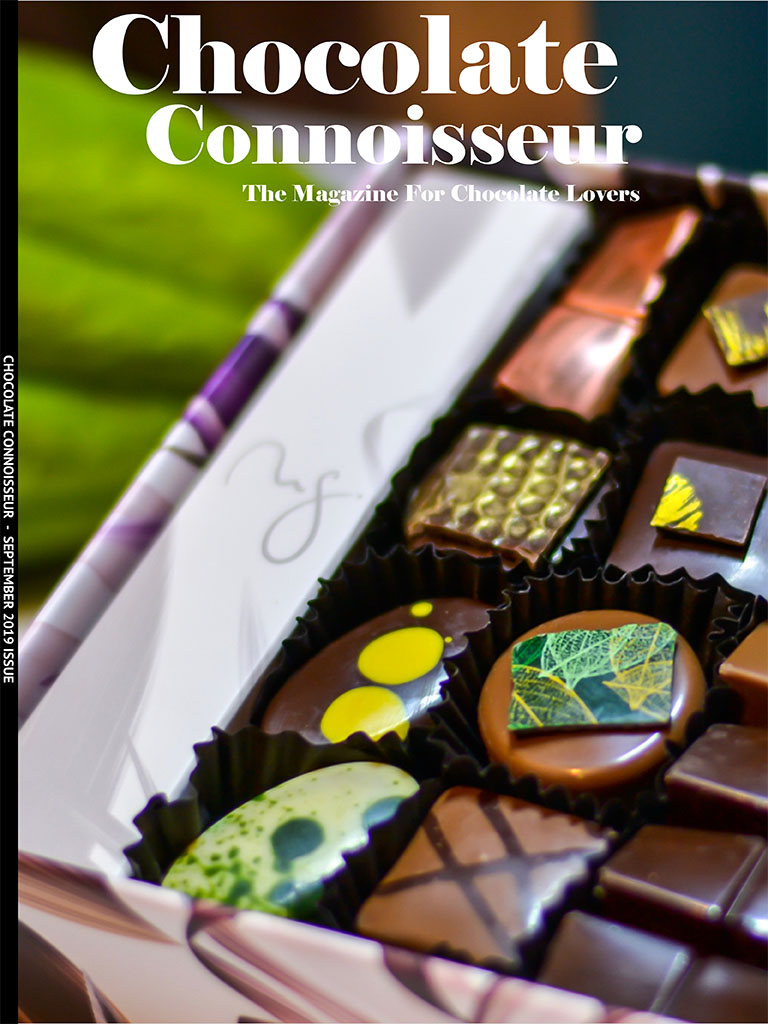In Focus:
Wabi Chocolate
by Fernanda Bravo
Born on the southern end of the world, between tango memories and Japanese contemplation, I bet you´ll never encounter more of a nomad than craft chocolate maker Natalia (Nati) Satto, the Italian-Argentinian-Japanese chocolatier, founder of Wabi, in Buenos Aires.
Wabi… a word that conceptualizes the beauty of imperfection, yet resonates as the perfect name for a bean-to-bar chocolate line.
Seven years ago, this wanderer pastry chef, with such a unique mixed background, still called Argentina home, although she kept moving from one city to another, trying different types of chocolate, raising a child, and chasing her dream.
“Women really are better at multitasking”, she jokes.
Coming from a family with varying origins and cultural influences, Natalia experienced several different types of cuisine and explored a huge variety of flavors… thoroughly embracing the diversity of her family kitchen.
Chocolate played a role in her childhood as well –
“As an Argentinian, chocolate has always been part of my life. We would enjoy a cup of ‘Submarino’ every afternoon during Winter, in any cafe around. It was –and still is! – a classic Argentinian winter drink, and I’d always go for the dark chocolate one.”
A Unique Past
Born in the small, historic town of ‘Concepción del Uruguay’ in Argentina, Nati’s family life always revolved around the kitchen. Many typical foods from Germany, Italy, Belgium, Japan, and of course Argentina, all parts of her diverse ethnic, cultural background, enriched her life at an early age.
“This ethnic mix was probably what gave me valuable tools to face life. And to enjoy travelling, which I do monthly, till today.
On the other hand, the sensory world was the center of many family meetings when I was younger, lots of cooking, of tasting, of mixing and combining different recipes. From Sauerkraut to Pasta to Chocolate and Medialunas.”
Nati’s hybrid background taught her to enjoy every cultural contrast… and to admire the different nuances of social behavior as well.
“My family, especially my grandparents, forged my character. Their way of treating me was always very harsh, disciplined, yet also very loving.”
In many ways, the woman Nati evolved into owes much of her character to such lessons, and of course to the countless Submarinos she shared with her Belgian grandmother!
Psychology vs. Chocolate
In the vast world of today’s chocolate makers and chocolatiers, we often discover professionals whose careers started far, far away from chocolate (people working in finance, entertainment, etc.). Frequently, chocolate only entered the converstation within a decade, or less, of any great chocolate maker taking the plunge into a new life in the chocolate world.
In Nati’s case, however, chocolate entered her world very early on, while she was just a baby.
“The inspiration of working with chocolate started early in my childhood, as chocolate has been in my family for generations. When I was a kid, I would have one bar after another, and these chocolate binge sessions usually ended in countless tummy aches.
I remember one night watching this TV program which showed amazing chocolate sculptures. I knew right there that an infinite world was hidden behind chocolate and I needed to discover it.”
Despite such dominate chocolate influence, Nati’s career still began far removed from cacao –
“Once I finished school, I did just like everybody else – I left for Buenos Aires, the big city. I started my Psychology Degree at Universidad De La Plata.”
She recalls the nice feeling of getting close to people, as a student working in hospitals.
“I learned from them, from their problems, but with time, I realized I enjoyed this perspective from a creative approach, rather than a psychological one.”
Life moved along just fine… but the chocolate urge constantly lingered.
Eventually, Nati started dividing her time between Psychology studies and her chocolate passion. She took some basic chocolate and pastry lessons, tutelage that paved the way to her final plunge –
“In the middle of my Psychology studies, at 22, two major things happened, completely changing my life. One, I gave birth to my son, Augusto. And two, I finally decided to become a professional chocolatier.”
Fueled by her diverse culinary experiences, Nati felt a growing desire to create something of her own linked to chocolate. It comes as no surprise that her father, Sergio Satto – a disciplined and independent man of Japanese ancestry – played a pivotal role in Nati’s new adventure.
She never felt threatened or intimidated by the idea of setting out on her own, doing what she loved the most. She elaborates –
“In my family, no one has ever been an employee. Not even my grandparents, or aunts and uncles. It was a kind of family philosophy, that it didn’t look appropriate to work for someone else. I was always taught to build my own little business.”
With that sort philosophy as a backdrop, Nati rather easily decided to invest in her very own chocolate shop, which opened its doors in a small town near Buenos Aires, called Tandil. Moving and starting a new business in a new town certainly required a great deal of planning and effort, but Natalia, already well accustomed to temporary homes and a hectic, nomadic pace, eagerly accepted the challenge.
“I knew much less than I thought I knew, but 15 years ago it didn’t show much,” she laughs.
As tends to be the norm, fighting to do what one loves requires a great deal of sacrifice and persistence. Natalia had a son to raise, a shop to look after, and chocolate lessons to attend, but she persevered, starting work on her professional Chocolatier Degree at Mausi Sebess in Buenos Aires.
Every week she would pack her pastry kit and some clothes to then travel for several hours to get to pastry school, leaving Augusto with her parents. She trained there for 3 years.
“It was really tiring but I always came back home with a huge smile” she happily evokes.
One Very Special Mentor
Nati knew it would take a lot of practice, and that she’d need to be a good observer and listener as well, to eventually become a good chocolatier. Her natural competitiveness kicked into high gear throughout those years, and she put all her heart and soul into chocolate. She fondly remembers those days –
“We were a small group and the 1st generation of the pastry school. I remember I would look at my classmates’ marks, always comparing myself to others. I loved a good ‘10’.
Don Bernardo was one of the Professors there, he wasn’t well liked because of his temperament and grumpiness but boy was he respected! He also managed and planned for big retail chocolate brands.
Don had a developer profile. One day he gave me a mark which I thought was completely unfair given the accuracy of my answers and considering the fact that mine were better than my friend’s, who received a better mark, I went complaining to him. I didn’t care about his bad-temper and I thought I deserved an explanation.
I must say I was a little bit scared of triggering any less favorable results. But he looked at me and said something I cannot forget – ‘there is no way I judge you by the standard. You’ll reach as far as you want. Do not settle for the simple.’”
Undoubtedly, Don’s response even further lit Natalia’s chocolate fire. In fact, today she still uses that same slogan with her own chocolatier students.
“Of course, you can’t measure everyone with the same standard. I see it in my students every day. Some of them own a temperament that will take them very far in the chocolate business. I give everything I have to all of my students, but to those tough ones I also give myself entirely.”
Once pastry school ended, Natalia searched for mentors, a chocolate guru to help her perfect her own art in chocolate making. For a few years, it that very same Don Bernardo inspired her again and again to follow the chocolate path.
“Along with two friends we asked Don Bernardo to teach us on a special level, a deeper level, so that we could acquire all the knowledge that you’d never get at school.”
In an empty apartment, two blocks away from El Obelisco, the three friends assembled a small kitchen complete with a tempering table, an oven, and a small microwave – ready for Don’s lessons each and every Wednesday.
“It was our small private amusement park. People heard about it and suddenly they were asking if they could come and join us. But it was our thing!”
Taller de Chocolate
Natalia closed in on her chocolate maker dream, but at the time, chocolate held little sway in Argentina. Chocolate makers were few and far between in the land of the gaucho.
“I truly believe that chocolate is so much more than a sweet treat. It is something that has the power of bringing people together. It attracts people. Everyone wants a piece!
And I like listening to people, being around them, sharing with them, just as I did at the beginning of my Psychology lessons. So, one day, I thought this place would actually be so much better if we could bring people together around chocolate.
We asked Don Bernardo if he’d open up his lessons for other students. He decided it was a good idea and we named this little “school” Taller De Chocolate (Chocolate Workshop or Atelier), back in 2007.”
Now completely dedicated to chocolate, Natalia’s path took a surprising turn when, as fate would have it, the great professor needed to miss some days at the school. Nati stepped in to teach the students, now accustomed to Don’s teachings, and they wound up loving her teaching style.
Suddenly students asked to attend on the days she taught instead. As a result, the school’s enrollment soon increased.
“I never thought of myself as a Chocolatier Teacher, but apparently the students liked my way of teaching, and I liked it too! So in a matter of days I was teaching regularly as well, along with Don Bernardo.”
Natalia eventually took the profits from her chocolate shop in Tandil and invested entirely in Taller de Chocolate. Her Psychology background served her well through the teachings., and the workshops grew exponentially.
More gorgeous creations from Taller de Chocolate
From the very beginning she embraced the challenge of developing a program to meet all the needs required to inspire the budding chocolate industry in Buenos Aires. Until then, there were no chocolate schools in Buenos Aires. As Nati happily notes, she truly developed her own brand –
“Taller De Chocolate became a synonym for dedication and specialization, of creativity and innovation.”
Once a Traveler, Always a Traveler…
Yes, success felt wonderful, but the intrinsically restless Natalia soon needed a change. With twenty different cities to her credit already, it comes as no surprise. “I need it,” she says.
In between her lessons at Taller de Chocolate, she set out on another bunch of trips, including Brazil, Germany, and Spain, to keep honing her chocolate craft. Her love for cacao only grew –
“I started reading more about cacao, focusing on chocolate’s main raw material. I found it fascinating! There were some wonderful notes from Astrid Gutsche – Gaston Acurio´s amazing wife and world class pastry chef – which promoted cacao and its use in a more natural way.
And then I learned that Pierre Marcolini had gone to Perú to study the Cacao Albino from Piura, the Gran Blanco. This just made me crazy. I felt encouraged to go as well!”
In a matter of days, she found a Farm in Piura, a cooperative. She called them, booked a flight, and landed there alone. Talk about a chocolate adventure…
“I had no plan, it was my first time in Peru. I knew no one. Some men from the farm were waiting for me at the airport, and they took me on an unforgettable tour.
I thought of it as a huge discovery, there was so much to learn. The farms are places where I feel like time stops. I wish I could stay there forever.”
What an amazing experience… her first time in a cacao farm, trying nothing less than the prized Cacao Blanco Peruano!
In 2011, with the moving bug biting once again, she decided to take a chance on Santiago, Chile. She started offering chocolatier lessons, and once again people responded well.
By the last semester of 2012, a big chocolate House, La Fete, contacted Nati on her birthday, December 31st, to offer her a position in the company, headquartered right in metropolitan Santiago. Two days later, Nati started there as a Development and Innovation Manager, a very similar position to the one originally held by her admired Professor Don Bernardo, many years before.
Chocolate had come full circle, and she spent her days toggling between creative processes, chocolate machines, and business management, loving ever minute of it.
“I didn’t really doubt it. I packed once again, and off we went with my son.
It was a great learning experience. It’s a huge company, whose factory produces more than 30 tons of bonbons monthly.
I learned that I love planning and discovering how to make the most out of the chocolate machinery.”
Chocolate Restless
After a little more than a year went by, Nati’s restless spirit once again weaved its way into her chocolate world. She felt a desire to teach once again, feeling it would be beneficial to make new connections. Also, perhaps more than anything, she felt a desire to remain loyal to her aforementioned entrepreneurial family philosophy.
“I started again, built an Atelier from scratch, first at home. It quickly grew in size, however, so I had to move to a bigger house, which soon became the location of my Taller De Chocolate.”
Although in one way Santiago serves as home (at least for her new classroom, where she teaches, crafts chocolate and provides technical advice to top chocolate businesses), that’s not quite accurate. Nati’s still always on the move, traveling to different parts of the world, visiting farms, looking for beans, and popping up every month in Buenos Aires as well.

Proud Taller de Chocolate graduates!
“Opening a business in a different country, was not really that hard for me. I’ve been trained for this, so starting was very simple, I just replicated the same idea in a different location. I am restless and curious, and those who know me closely know that I love doing many things at the same time, so I never felt afraid to take the plunge.”
She laughs as she continues explaining…
“I think that chocolate will always be my best “excuse” to look for new projects, to integrate with the culture of the place I’m currently living in, to share and learn from any community. I think all those belly aches were so worth every chocolate piece!”
Nati says she wouldn’t be here if it weren’t for that sweet treat.
“I’ve been in so many places, using my craft as a vehicle. This has made me understand life in a different way. No place is same to another. Yet everyone everywhere connects with chocolate in a very similar way. It makes me feel free and at home all at the same time.”
Despite all her talent, Nati knows she has been quite lucky to meet a few legends of the chocolate world, some of them immigrants, others, daughters and sons of immigrants… people who forged their stories in the space between cacao and conching machines.. people she feels so fortunate to learn from, to partake in their collective knowledge.
“I think we all need people to inspire us. We need people who are on top of us, who we know are so much better than us, to help us remain humble and not lose our way. I have known these people, some of them were my mentors. I learned from my experiences with them to stay on track.”
Perfect Imperfection: Wabi Chocolate
For those familiar with Japanese culture, the concept of Wabi-Sabi registers as something quite proverbial. It reflects a philosophy centered on the acceptance of transience and imperfection.
Coming from Japanese lineage, Nati decided to name her brand-new Bean to Bar line after this concept, as it echoes everything she enjoys about the craft chocolate movement.
“I resolved to enter the bean-to-bar movement because there is more consciousness and genuineness across every level of this chocolate industry.
From the farmer who dedicatedly grows and harvests the wonderful pods I saw for the first time years ago in Peru, to the feeling I get when I witness my customers try a bar for a first, second, or even third time and realize how different the same bar can be…”
Her desire to craft chocolate from the bean gradually grew over her time within the chocolate world. The creative process, her love for chocolate machinery, and an ever-increasing awareness of the industry solidified Nati’s resolve to create a finished product that highlights the very different characteristics of the raw material itself.
“I realized there is magic in every taste and texture, and it made my customers vibrate differently.
It’s commonplace in the conventional industry to focus on art and orthodox perfection. Every piece, every square of chocolate must look and taste plainly perfect. There is a standardization of chocolate flavor and appearance.
But Wabi speaks of finding beauty in imperfection, and that is what I experience today professionally and personally after several years in this industry”.
She adds –
“I believe in the nobility of cacao. I think flavors and textures and aromas must and will always be different. Over the years, I came to understand that we, as chocolate crafters, only learn the technique. In the end, it is our customer’s palate that dictates the ‘truth’.
Each palate is different. And for me, this variety is wonderful because it means that many people will enjoy my bars in very diverse ways.”
Gradually developing her new bean to bar line since 2016, the inspiration for her colorful, vibrant packages actually sprang to life on one of her numerous trips to Colombia, where she now sources her beans.
“I have been in the industry for more than 15 years, and the launching of this line is the first time I feel I can communicate all the colors, textures, forms, flavors, and aromas that the chocolate culture encompasses… a complete sensory experience born straight from the bean.”
She cleverly thought of a wrapper that reflects the colors and landscapes of cacao- producing countries. Wabi’s packaging tells stories about cacao-growing families, about farms and harvesting. Nati sought to share the history of cocoa with others.
Wabi 80% Dark Chocolate Salted Almonds
A Magical Bean
In preparation for Wabi’s launch, to achieve the chocolate flavor profile she desired, Nati tested several beans.
“I tried a lot of origins. I love Perú and Bolivia. Beans from Esmeraldas, as well, in Ecuador. I tested so many wonderful beans but always felt they didn’t match the characteristics I was looking for…”
In 2018, during one of her trips to Solingen, Germany, she met two cacao growers, Juan Pablo and Christian Vélez. The farmers eventually offered her some beans to try.
“They are cousins and own a small family farm named ‘Betulia’ in Colombia. I took the beans they gave me and analyzed them. Wow! They were all completely white. All of them! I had been given beans with a high Criollo genetic percentage.”
The sophisticated profile of the cacao won Natalia’s heart. Juan and Christian started their farm from scratch. They chose the land, free from cadmium, on a spot located in Maceo, in the department of Antioquia, a vast mountainous zone where the Basque has had a lot of influence.
They rigorously select every cacao tree to plant on the farm. Hacienda Betulia is well-known among chocolate makers for the careful management of every detail, for the special attention given during processing, and for the elegant characteristics of the three genetic types of beans they harvest as well.
Nati fondly remembers her fateful trip to Germany –
“By the last days in Solingen, Christian gifted me with a big portion of beans, which I kept in a new suitcase I bought with the only goal of carrying them back. I cheerfully thought of all the possibilities and things I could do with those beans and felt like a kid at Christmas.
When I landed in Chile, this beloved suitcase never arrived. After lots of phone calls, emails, and everything you can imagine in an effort to get my suitcase back, it finally arrived… but completely empty!”
Thankfully the Velez cousins sent her, very carefully this time, another batch of beans, and the rest is history…
Wabi just officially opened its doors in early September. It’s a cozy spot where chocolate lovers can learn the process, taste some amazing beans, or simply enjoy one of Nati’s exquisite chocolate bars.
“I love doing this. Everything. The beans, my machines, I feel they do magic, they are really beautiful. I also hope in a not too distant future, I will have my own farm and will be able to develop a product from the tree.”
Wabi Vegan Chocolate Berries B6 85%
A Closer Look
The Betulia farm harvests three types of cacao, which are named B6, B8, and B9. Although each variety offers a fairly different profile, they do all share an unusual fresh, citrusy note.
Natalia chose the B6 variety to craft her 80% Dark bar, with an end result that’s creamy, sweet and fruity – quite the impressive feat for such a dark chocolate bar. Nati explains –
“I added some goats milk for smoothness. Even today, this first bar is still a favorite. It’s my most-complimented bar.”
Yes, for good reason, as the 80% Dark bar is a bonafide WOW! It starts with no modesty, and a serious bouquet of lemony notes, which soon evolve into a very chocolatey suggestion that builds up, happily accompanied by a pleasant, acidic tinge. It lasts and lasts, even after the last bite disappears…
Nevertheless, Nati did not limit her creative manner to bars only. Her line also includes mendiants, coated dried fruits like chilies and berries, truffles, and ‘bariloches’ a classical Argentinian treat – because she of course could not let that Andean spirit out of her craft.
Her philosophy truly remains one of a classical bean-to-bar crafter –
“I am really proud of Wabi. Everything is organic, low sugar and gluten free. What matters the most is to highlight the profile of the bean.
Although Nati of course understands the importance of taste and flavor development, she also recognizes the crucial importance of a fair and equitable chocolate supply chain.
“Farmers deserve an ovation as well because a big part of the result, if not all of it, is owed to them. Also, it’s important for consumers to know they’re enjoying a wholesome, more noble product.”
Since she first began traveling to different cacao farms several years back, Natalia quickly learned how much work still needs to be done for the families working in the fields. Purchasing beans at a fair price directly helps those in real need.
“I would love the bean-to-bar movement to one day become so successful, that no one can lose sight of what’s important. I know there is now some regulation, but I believe that change should come from our genuine desire to contribute to a more honest, healthy and fair food industry.”
Because of her focus on the authenticity of food, Nati doesn’t allow any synthetic products in her kitchen.
“I know there are substitutes for sugar, and I study them, try and give them an opportunity. But I will always prefer cane, coconut, or white sugar, in low proportions.
I do not understand the benefit of replacing sugar by almost 40% with a sweetener with a low glycemic index, since it still has an artificial nature. That does not contribute to the health of those who consume it.”
Wabi’s line runs the full spectrum from milk chocolates to 80% dark bars. All of them very balanced, with a soft and creamy texture, where the flavor of cacao remains unchanged, but well accompanied when the bar contains any inclusions.
For her inclusion bars, Nati’s experience as a Developer and Innovation Manager helps immensely, as she still remembers many different pairings, aromas and textures.
“I like soft milks, in low doses, where cocoa is always the protagonist.”
A Closer Look at Wabi Chocolate Bars
All of Nati’s bars are organic and single origin.
They all also share a very fruity profile, which I personally adore, so it’s not easy to select a favorite. Despite the similar profile, Wabi’s bars usually don’t offer one dominant note; instead, each bar tastes quite balanced.
I decided to start with the B6 75% Azúcar de Caña (Cane Sugar), with its elegant profile, very balanced with a creamy mouthfeel. The flavor develops quickly and soon I was enjoying its nutty, fruity sweetness. A toastiness kicked in for an aftertaste, not a surprise given the bar’s cane sugar content.
I then moved on to the B9 85% Azúcar de Coco (Coconut Sugar). Certainly not a shy bar, shy tasters may want to stay away. Its coconut notes hit you from the very first taste, while its notes of pineapple and a pleasant bitterness strike hard.
Next came B6 80% Leche de Cabra (Goats Milk), with a surprising, almost gold-like color that truly stands out for a chocolate bar. It’s a very smooth experience, with a soft acidity that beautifully frames the cocoa notes. There’s a reason why this bar is everyone’s favorite!
For the grand finale, I tasted the B9 65% Nibs y Sal de Cahuil, and its cacao profile exquisitely highlighted by a special Chilean salt. With a stark contrast between the natural fruitiness of the bar and the bitterness of the nibs, every flavor is enhanced. The toasty notes of the cane sugar grow stronger with time, balancing out the bitter notes.
Moving Forward
Natalia hopes to add another two or three origins to her craft line soon, potentially planning new research trips to Costa Rica, Nicaragua, and maybe to Brazil or Bolivia, in search of something very fruity.
“I am always looking for new profiles, and for a while I turned my head towards Ecuador. Although there is no question of its wonderful beans, Ecuador already has great representation in the bean-to-bar world.”
She even mentions Madagascar as a possible next option.
“There is this truffle that I make, with a nice cream cheese and high percentage chocolate. Over the years, I’ve been told this truffle is one of my best creations.
It’s very soft, somewhat acidic, with a lot of cocoa flavor… surely a very similar experience to the goat milk Wabi bar. I would love to prepare it using some Madagascar cacao!”
Knowing that her nomad nature won’t let her stay in one spot for too long, we can certainly expect the unexpected from Natalia and Wabi. Barcelona already sits close on the horizon…
“What I want to dedicate myself to now, is the strengthening of my line, and then to hopefully take it to other countries, other parts of the world, where I can get even more insight from new customers and tasters.
People here have a very traditional palate, so it would be interesting to get a further appreciation of my products.”
She also knows it’s her responsibility, along with every other stakeholder in the chocolate world, to promote a deeper understanding of the bean-to-bar culture.
“For this, I think formal tasting workshops and education are the best sellers. You have to be honest, respectful and collaborative with both crafters and customers… let them appreciate the story from scratch.
By doing this, you are providing them with the chance of give meaning to what they are having. To understand it in a deeper way, more than a simple candy.”
In the meantime, Nati will keep obsessing about the perfectly imperfect profile, developing new inclusion bars, and dreaming of packing her suitcase yet again, while we look forward to enjoying her next chocolate adventure as well!
For more on Wabi Chocolate, CLICK HERE to visit the Wabi Chocolate website. Please note, however, that it’s in Spanish, so you may want to use a web browser that translates.
You can also click here if you’d like to learn more about Taller de Chocolate on their website as well.
Then click the link below to connect with Natalia on social media.
+ PHOTOS BY WABI CHOCOLATE & TALLER DE CHOCOLATE

